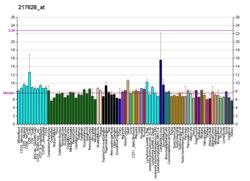Chloride intracellular channel protein 5 is a protein that in humans is encoded by the CLIC5 gene.[5][6]
Expression and localization edit
CLIC5 exists in two alternative splice variants, a smaller CLIC5A and larger CLIC5B protein.
CLIC5A is expressed chiefly in the renal glomerulus, specifically in podocytes. Within the cell, CLIC5A is localized to the plasma membrane and the cytosol, and associates and is regulated by the actin cytoskeleton.[6] CLIC5A can form ion channels in vitro and its channel activity is regulated by actin, though measurement of its chloride conductance in vitro suggests that CLIC5A is equally selective for cations and anions. Even so, the function of CLICs as bona fide ion channels is controversial and has been disputed.[7][8]
Function edit
Although chloride intracellular channel (CLIC) proteins were thought to be involved in ion transport in subcellular compartments, their actual functions suggest their role in diverse cellular and physiological functions including apoptosis and angiogenesis in CLIC1.
CLIC5A, through its interactions with the small GTPase Rac1, induces the phosphorylation of ezrin-moeisin-radixin (ERM) proteins and localized production of the phosphoinositide phosphatidylinositol-4,5-bisphosphate.[9] These two events activate ezrin, enabling it to couple transmembrane proteins to the actin cytoskeleton, which could represent a mechanism by which podocyte foot processes form to enable renal filtration.[10]
Clinical relevance edit
Two human families with loss-of-function CLIC5 mutations have been reported, with a total of 5 affected individuals. CLIC5 deficiency results in progressive hearing loss by the second decade, vestibular abnormalities, and kidney dysfunction.[11][12]
CLIC5A deficiency in mouse models potentiates glomerular injury in hypertension. In these mice, podocyte foot processes were also more sparse and disperse than in wild-type mice.[10]
See also edit
References edit
- ^ a b c GRCh38: Ensembl release 89: ENSG00000112782 – Ensembl, May 2017
- ^ a b c GRCm38: Ensembl release 89: ENSMUSG00000023959 – Ensembl, May 2017
- ^ "Human PubMed Reference:". National Center for Biotechnology Information, U.S. National Library of Medicine.
- ^ "Mouse PubMed Reference:". National Center for Biotechnology Information, U.S. National Library of Medicine.
- ^ Berryman M, Bretscher A (May 2000). "Identification of a novel member of the chloride intracellular channel gene family (CLIC5) that associates with the actin cytoskeleton of placental microvilli". Molecular Biology of the Cell. 11 (5): 1509–1521. doi:10.1091/mbc.11.5.1509. PMC 14863. PMID 10793131.
- ^ a b "Entrez Gene: CLIC5 chloride intracellular channel 5".
- ^ Jentsch TJ, Pusch M (July 2018). "CLC Chloride Channels and Transporters: Structure, Function, Physiology, and Disease". Physiological Reviews. 98 (3): 1493–1590. doi:10.1152/physrev.00047.2017. PMID 29845874. S2CID 44165561.
- ^ Jentsch TJ (January 2008). "CLC chloride channels and transporters: from genes to protein structure, pathology and physiology". Critical Reviews in Biochemistry and Molecular Biology. 43 (1): 3–36. doi:10.1080/10409230701829110. PMID 18307107. S2CID 86536670.
- ^ Al-Momany A, Li L, Alexander RT, Ballermann BJ (December 2014). "Clustered PI(4,5)P₂ accumulation and ezrin phosphorylation in response to CLIC5A". Journal of Cell Science. 127 (Pt 24): 5164–5178. doi:10.1242/jcs.147744. PMID 25344252.
- ^ a b Tavasoli M, Li L, Al-Momany A, Zhu LF, Adam BA, Wang Z, Ballermann BJ (April 2016). "The chloride intracellular channel 5A stimulates podocyte Rac1, protecting against hypertension-induced glomerular injury". Kidney International. 89 (4): 833–847. doi:10.1016/j.kint.2016.01.001. PMID 26924049.
- ^ Wonkam-Tingang E, Schrauwen I, Esoh KK, Bharadwaj T, Nouel-Saied LM, Acharya A, et al. (October 2020). "Bi-Allelic Novel Variants in CLIC5 Identified in a Cameroonian Multiplex Family with Non-Syndromic Hearing Impairment". Genes. 11 (11): 1249. doi:10.3390/genes11111249. PMC 7690789. PMID 33114113.
- ^ Seco CZ, Oonk AM, Domínguez-Ruiz M, Draaisma JM, Gandía M, Oostrik J, et al. (February 2015). "Progressive hearing loss and vestibular dysfunction caused by a homozygous nonsense mutation in CLIC5". European Journal of Human Genetics. 23 (2): 189–194. doi:10.1038/ejhg.2014.83. PMC 4297911. PMID 24781754.
Further reading edit
- Singh H (May 2010). "Two decades with dimorphic Chloride Intracellular Channels (CLICs)". FEBS Letters. 584 (10): 2112–2121. doi:10.1016/j.febslet.2010.03.013. PMID 20226783. S2CID 21056278.
- Maruyama K, Sugano S (January 1994). "Oligo-capping: a simple method to replace the cap structure of eukaryotic mRNAs with oligoribonucleotides". Gene. 138 (1–2): 171–174. doi:10.1016/0378-1119(94)90802-8. PMID 8125298.
- Suzuki Y, Yoshitomo-Nakagawa K, Maruyama K, Suyama A, Sugano S (October 1997). "Construction and characterization of a full length-enriched and a 5'-end-enriched cDNA library". Gene. 200 (1–2): 149–156. doi:10.1016/S0378-1119(97)00411-3. PMID 9373149.
- Shanks RA, Larocca MC, Berryman M, Edwards JC, Urushidani T, Navarre J, Goldenring JR (October 2002). "AKAP350 at the Golgi apparatus. II. Association of AKAP350 with a novel chloride intracellular channel (CLIC) family member". The Journal of Biological Chemistry. 277 (43): 40973–40980. doi:10.1074/jbc.M112277200. PMID 12163479.
- Suzuki T, Morita R, Sugimoto Y, Sugawara T, Bai DS, Alonso ME, et al. (August 2002). "Identification and mutational analysis of candidate genes for juvenile myoclonic epilepsy on 6p11-p12: LRRC1, GCLC, KIAA0057 and CLIC5". Epilepsy Research. 50 (3): 265–275. doi:10.1016/S0920-1211(02)00052-9. PMID 12200217. S2CID 9340681.
- Berryman M, Bruno J, Price J, Edwards JC (August 2004). "CLIC-5A functions as a chloride channel in vitro and associates with the cortical actin cytoskeleton in vitro and in vivo". The Journal of Biological Chemistry. 279 (33): 34794–34801. doi:10.1074/jbc.M402835200. PMID 15184393.
- Otsuki T, Ota T, Nishikawa T, Hayashi K, Suzuki Y, Yamamoto J, et al. (2007). "Signal sequence and keyword trap in silico for selection of full-length human cDNAs encoding secretion or membrane proteins from oligo-capped cDNA libraries". DNA Research. 12 (2): 117–126. doi:10.1093/dnares/12.2.117. PMID 16303743.
- Gonzalez A, Ciobanu D, Sayers M, Sirr N, Dalton T, Davies M (October 2007). "Gene transcript amplification from cell lysates in continuous-flow microfluidic devices". Biomedical Microdevices. 9 (5): 729–736. doi:10.1007/s10544-007-9083-1. PMID 17492382. S2CID 1953414.
- Singh H, Cousin MA, Ashley RH (December 2007). "Functional reconstitution of mammalian 'chloride intracellular channels' CLIC1, CLIC4 and CLIC5 reveals differential regulation by cytoskeletal actin". The FEBS Journal. 274 (24): 6306–6316. doi:10.1111/j.1742-4658.2007.06145.x. PMID 18028448. S2CID 22494250.
External links edit
- CLIC5+protein,+human at the U.S. National Library of Medicine Medical Subject Headings (MeSH)
- Human CLIC5 genome location and CLIC5 gene details page in the UCSC Genome Browser.
This article incorporates text from the United States National Library of Medicine, which is in the public domain.





